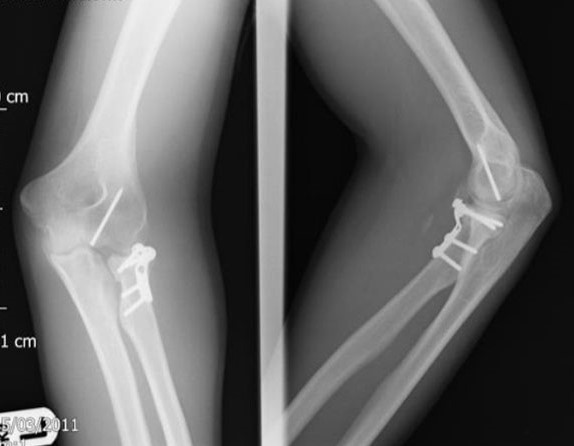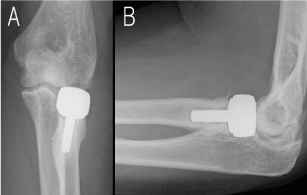Radial head and neck fracturesThe radial head is the top end of the radius where it joins the humerus and the ulna at the elbow. In order for you to be able to turn your wrist (pronation and supination), the radius is shaped like a disc which can spin on the capitellum (the ball on the outside half of the end of the humerus). If you fall on an out-stretched arm the force is transmitted through the forearm and into the elbow. The arm is in a natural degree of valgus at the elbow which means it tends to tilt and crush the radial head. There are two ways that these injuries can be managed; with and without surgery.
The two images on the right are of radial head fractures. The top image shows a mild fracture with a minimally displaced crack. The lower image is a much more severe injury with multiple fragments.
Non-operativeThe vast majority of isolated (just a radial head fracture on its own) radial head and neck fractures are managed without surgery. Often they are undisplaced and the only sign it is there is that a shadow appears on the front and back of the humerus on the lateral view X-ray (called the sail-sign). The advice for these injuries is to start gently moving the elbow early-on to prevent stiffness. So may be a sling will help with the pain for a week but then you must move the elbow but avoid heavy-lifting for around 6 weeks. If the fracture is somewhat displaced then it can still be managed without surgery. The elbow is very tolerant of some angulation in this area. By this I mean that you can still gain a good outcome without the fracture healing in exactly the right position. You may have some restriction of pro-supination (twisting your wrist) but it is unlikely to be functionally a problem. If the fracture is very displaced then surgery may be recommended.
  OperativeSurgery for these injuries involves either putting in screws and may be a plate, or a radial head replacement. There are quite limited occasions where screws and a plate are appropriate. Broadly speaking if the fracture is in more than 2 bits then screws and a plate are unlikely to offer stable enough fixation. There is no point in having such tentative fixation that early mobilisation post-operatively cannot be done. The whole point of addressing these fractures is to ‘stabilise and mobilise’. If the fracture is not reconstructable with plate and screws then a radial head replacement may be performed. The fracture fragments are removed and a piece of metal shaped exactly like a radial head and the correct size for you is inserted. It is usually done as a press-fit technique which means that it is jammed in the bone so that it doesn’t move in the bone. After insertion the skin is closed and there should be no reason why you can’t get the elbow moving gently within a few days. There are some rare circumstances where the radial head can be excised (removed) and not replaced. If a surgeon is going to do this, they need to be sure that the elbow will be stable (won’t dislocate) without the radial head.
|